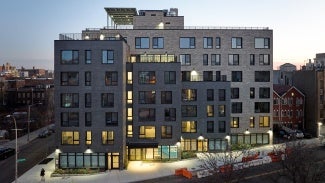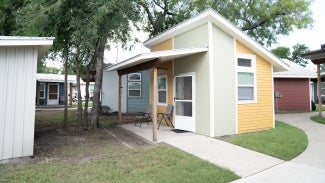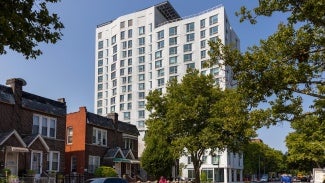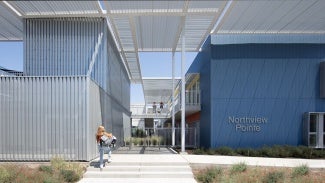
Designing affordable housing with compassion and resilience
Learn how three organizations use regulatory expertise and creative problem-solving to make affordable housing happen.
Shelter anchors Maslow’s hierarchy of needs, yet nearly 800,000 people experienced homelessness in the U.S. last year. Even if a person’s housing seems stable, circumstances can change quickly: They might lose the ability to work because of an injury or illness, then lose their job and health insurance. In the absence of public safety nets and familial support, eviction follows. Life on the streets may cause a constant state of fear and hunger, leading to substance abuse and addiction.
Safe, secure, and reliable housing can help end the spiral. And seeking affordable housing is more common than one might imagine, says Brooks + Scarpa cofounder Lawrence Scarpa, FAIA: “Many of the people who live in affordable housing are a lot like you and me.”
However, the supply of affordable and supportive housing developments falls well short of demand for many reasons. To succeed in this market, architects need compassion and humility but also regulatory expertise and conviction.
Over the threshold
For nearly four decades, Magnusson Architecture and Planning (MAP) has designed affordable, supportive, and senior housing, mostly within New York City. The sector requires “such a level of expertise because there’s so many regulations, design requirements, and nuances involved,” says Brian Loughlin, AIA, a principal at MAP and cochair of the AIA New York Housing Committee.
Angela Brooks, FAIA, sees a similarly high bar in Los Angeles. A Brooks + Scarpa cofounder and managing principal, Brooks says that owners and clients—typically banks, lenders, and developers—want firms with experience that aligns closely with their project.
To those looking to enter the sector, Loughlin and Brooks recommend partnering with a firm or designer with affordable housing experience. For example, Scarpa and then–business partner Gwynne Pugh, FAIA, first teamed with Steven Kodama, FAIA, on the 44-unit, sustainable, and affordable Colorado Court development in Santa Monica, California.
Sarah Satterlee, AIA, is the senior director of site operations at Mobile Loaves & Fishes (MLF), the organization behind the landmark Community First! Village in Austin, Tx. Having seen what works for the development’s approximately 500 neighbors—individuals who have experienced chronic homelessness—she has specific expectations for prospective design firms.
“We love architects that are willing to listen and partner [with us] instead of trying to impose something they think might work,” Satterlee says. In all of their requests for proposals and qualifications, she and her team include the village’s design philosophy upfront. The village, now in its third and fourth phases, will eventually house approximately 1,900 neighbors over 178 acres.
Development insights
Developers need help from architects to maximize a site’s potential. In response to that need, Brooks and Scarpa cofounded two nonprofits. Livable Places, Inc., develops sustainable mixed-use housing on underutilized land. And the Affordable Housing Design Leadership Institute “offers a space where developers can come with a project and a problem and meet with experts—architects and other people who can help them make better decisions,” Brooks says.
In one instance, an East Coast developer sought land to build an affordable housing complex. “In Los Angeles, there’s [nowhere] someone could buy a 200-foot-wide blank parcel,” Brooks says. “You have to cobble [parcels] together.” By chance, Brooks + Scarpa was renovating a high-rise building on a spacious lot for that developer. “We showed them how they could … move the lot line down 50 feet.” The developer could then build their project without purchasing new property.
Regulatory resilience
In the affordable housing market, architects must have mastery over regulations, land use policies, and many other requirements. For instance, New York City has a building code distinct from the International Building Code, which most jurisdictions in the country follow, Loughlin says. Each lending institution will typically also have its own rules, prescribing parameters like unit size and density.
Though the regulations are many, Loughlin says MAP “always reminds our clients and our teams that they are effectively meant to protect the residents.” Someone who can afford market-rate housing can move out if their unit is inadequate. Vulnerable populations on limited incomes don’t have that agency.
Still, the tough regulatory environment can slow the efficient delivery of affordable housing. For example, the State of California and Los Angeles County require developers to pay commercial prevailing wages for residential projects exceeding four stories.
But in parts of Los Angeles, Brooks says, the maximum building height is five or six stories. As a result, developers are “not going to build one extra story and get kicked into this higher construction cost [tier]—it doesn’t make any sense,” she says. “So we’re building only four stories [of affordable housing], which also doesn’t make sense.” If cities truly want to provide more affordable housing, Brooks believes they need to overhaul their entire review process, including project financing and regulations.
NIMBY resistance
With the tall stack of regulatory paperwork, many affordable housing developments may lose their momentum, funding awards, and site approvals. And this might be exactly what some neighborhoods want. With one exception over their multidecade tenure in affordable housing, Brooks and Scarpa have faced pushback for every project in the sector.
Loughlin recalls a community whose residents argued a proposed 13-story building would cause too much shadow. Then residents realized the site was to its north, so their concerns switched to parking. The real source of the concerns was the makeup of future residents. MAP helped the community become comfortable with how the property would be managed and integrated their input into several design components. The process, however, extended the project schedule by two years.
Satterlee is familiar with NIMBYism. This year, Community First! celebrates the 10-year anniversary of its first neighbor moving in. Prior to finalizing the location of its first phase, “I think we were NIMBY’d out of four or five other sites,” she says. The property MLF ultimately developed sits in an extraterritorial jurisdiction outside the City of Austin. It has access to city utilities and seeks commercial site development permits, but it does not have to undergo the review process for full-purpose zoning.
Still, Community First! wanted good relations with its surrounding communities. Prior to anyone moving in, MLF invited the public to experience a model of its village, walk the gardens, and explore the micro houses. Today, the village regularly hosts community events, such as farmers markets, movie nights, and a Christmas celebration. “We strive to be good neighbors,” Satterlee says.
Great architects and neighbors
To maintain a lasting presence, MAP has conducted both post-occupancy surveys and on-site volunteer projects. Past initiatives include stocking school backpacks for kids who were formerly homeless and painting murals with residents. “It reinforces that this is not a one-and-done project for us,” Loughlin says.
Brooks and Scarpa regularly visit their completed housing developments and seek resident feedback. For instance, based on such feedback, the firm has raised certain courtyards above the street level to make them safer while maintaining a visual connection with the street. That approach is visible at The SIX disabled veteran housing project.
“Listening to people who have that lived experience informs the design,” Brooks says. “If you don’t talk to people who are living in your buildings, you’ll never get that.”
Worthwhile outcomes
Despite the obstacles architects face in the affordable and supportive housing sector, expanding housing access to those in need make their endeavors worthwhile. For individuals who have experienced chronic homelessness, “having somewhere you can call your own is huge,” Satterlee says.
To leverage site potential, “the industry is going to need designers more and more,” Scarpa expects. Developers also see design as an equalizing tool that rebuts common complaints like, “They’re going to come in here and build slums.” When owners hire firms that bring “good design to housing,” he says, “that argument is no longer on the table.”
“If you want to talk about well-being and saving people’s lives, providing housing is what does that,” Brooks explains. “It makes a stronger community for everyone.”
For more information about AIA’s support of the ROAD to Housing Bill, click here.
Wanda Lau is a freelance writer covering architecture and design and a former editor of ARCHITECT magazine. She lives outside Chicago.






